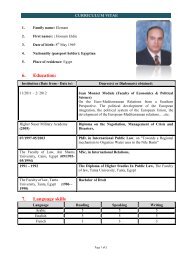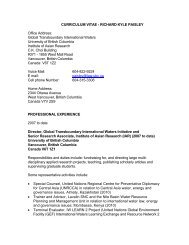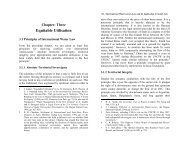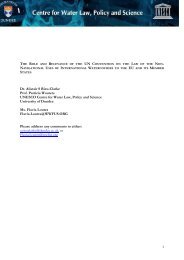a letter from research engineer, Cliff Goudey, of the MIT Sea Grant ...
a letter from research engineer, Cliff Goudey, of the MIT Sea Grant ...
a letter from research engineer, Cliff Goudey, of the MIT Sea Grant ...
You also want an ePaper? Increase the reach of your titles
YUMPU automatically turns print PDFs into web optimized ePapers that Google loves.
Page two<br />
I am intrigued with <strong>the</strong> idea <strong>of</strong> SpraggBag operations in a consistent, favorable ocean current.<br />
As you recall, none <strong>of</strong> our very-positive <strong>engineer</strong>ing and economic analyses enjoyed <strong>the</strong> boost<br />
that would be realized when <strong>the</strong> transit is assisted by such conditions.<br />
While this situation would have a very favorable impact on towed operations involving long<br />
trains <strong>of</strong> SpraggBags and high-powered tugs, <strong>the</strong> fair-current scenario combined with society’s<br />
interests in minimizing its carbon footprint brings with it some very intriguing possibilities. For<br />
example, and depending on <strong>the</strong> current velocities, <strong>the</strong> use <strong>of</strong> solar-powered propulsion might<br />
become a realistic alternative. Looking at a single 25-megaliter SpraggBag, we have<br />
approximately 2,000 sq. m. <strong>of</strong> exposed surface area. Even based on modest PV performance<br />
rates, that could yield over 100kW <strong>of</strong> power. That would translate into in excess <strong>of</strong> 150<br />
horsepower <strong>of</strong> electric propulsion.<br />
It should interest you to know that I have recently been working on mobile fish-farming<br />
operations – self-propelled ocean cages in particular. I have <strong>engineer</strong>ed electric propulsion<br />
systems that yield over 170 pounds <strong>of</strong> thrust per horsepower. That is approximately five times<br />
<strong>the</strong> thrust-per-horsepower ratio <strong>of</strong> ocean-going tugs. I am conducting sea trials <strong>of</strong> this system<br />
later this month in Culebra, PR.<br />
This zero-carbon approach would be competitive even in a conventional delivery scenario.<br />
However, in a favorable current, <strong>the</strong> option <strong>of</strong> one solar-enhanced SpraggBag towing a modest<br />
train <strong>of</strong> passive units <strong>of</strong>fers a stunning opportunity. Indeed, depending on <strong>the</strong> intensity and<br />
predictability <strong>of</strong> <strong>the</strong> current, <strong>the</strong> self-propulsion requirement might be modest; only what is<br />
needed to keep <strong>the</strong> transits along a prescribed route. I’d enjoy exploring <strong>the</strong>se concepts fur<strong>the</strong>r if<br />
<strong>the</strong> details <strong>of</strong> a route and delivery requirements can be specified.<br />
You also mentioned that some people have had questions about <strong>the</strong> SpraggBag technology’s<br />
ability to contain such massive amounts <strong>of</strong> water. I’m not sure how to respond except to say that<br />
our initial analyses were exhaustive, our material testing program was rigorous, our model tests<br />
verified <strong>the</strong> sea-keeping predictions, <strong>the</strong> prototype inflation tests proved <strong>the</strong> adequacy <strong>of</strong> <strong>the</strong><br />
fabrications, and <strong>the</strong> pilot-scale demonstration tows revealed <strong>the</strong> feasibility <strong>of</strong> <strong>the</strong> entire system.<br />
Suffice to say, <strong>the</strong> basic questions about <strong>the</strong> SpraggBag mode <strong>of</strong> water delivery have been<br />
answered. What remains is customizing <strong>the</strong> components and <strong>the</strong> operations to <strong>the</strong> particulars <strong>of</strong><br />
<strong>the</strong> route.<br />
I hope <strong>the</strong>se comments are useful in explaining <strong>the</strong> key differences between <strong>the</strong> SpraggBag<br />
system and some <strong>of</strong> <strong>the</strong> inferior approaches to water transport that may have given rise to<br />
skepticism. Please let me know is <strong>the</strong>re is any way I can help in conveying <strong>the</strong> merits <strong>of</strong> <strong>the</strong><br />
SpraggBag technology.<br />
Sincerely,<br />
<strong>Cliff</strong> <strong>Goudey</strong><br />
Research Engineer












